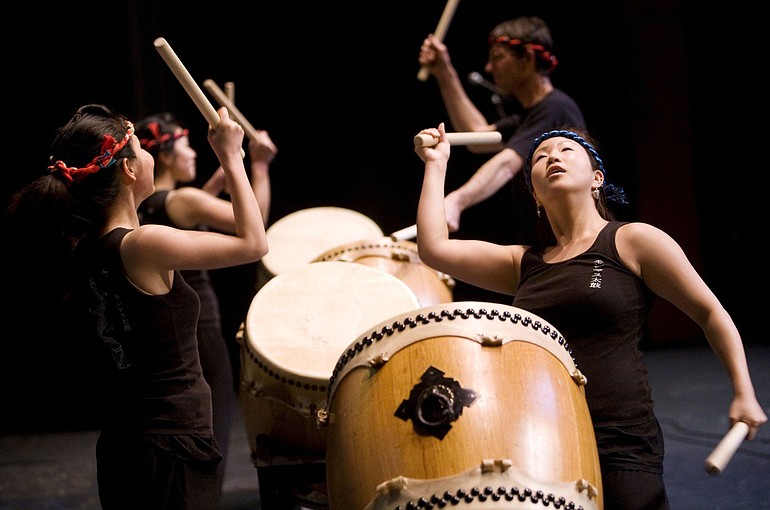WASHOUGAL — With a few delicate strokes, Chelsea York used a brew of water and charcoal scrapings to turn a word into a work of art.
With a rhythmic flurry of drumstick strokes, Todd Wilson and his taiko ensemble brought down thunder inside Washougal High School’s auditorium.
With a quick stroke to the head, Matthew Bullene’s kendo opponent delivered a blow that had the Washougal senior’s ears ringing an hour later.
Those were just some of the aspects of Asian culture on display Saturday afternoon in the school’s fifth annual Japanese Festival.
“We like to share Japanese culture and different Asian cultures with people in Washougal,” Shoko Fuchigami said.
Fuchigami teaches Japanese at the high school, and her students hosted several areas where activities were displayed.
Hands-on opportunities during the five-hour event included the paper-folding art of origami and the manga style of comic artwork.
York, a Washougal junior, explained the complex brushwork of Japanese calligraphy. She started by rubbing a chunk of charcoal on a grinding surface.
“You add water, and you have ink,” York said.
She dipped her brush into the ink, then carefully swept a black ribbon of ink on the white paper — the first element of a word.
“You can put a lot of emotion into it,” she said, although other aspects of the art are pretty strict.
“You have to learn to do the strokes in order,” she said. And just mastering the vocabulary “takes a lot of study.”
As a member of Monmouth Taiko, Wilson puts a lot of emotion into his performance, too. The drum club was one of the headliners when the festival moved into the Washburn Performing Arts Center from the high school’s commons area.
The group started in 1996 at Western Oregon University in Monmouth.
“We had to make our own taikos,” he said. “It was two years before we performed.”
The sound of percussion isn’t the only thing Wilson and his band mates bring to a concert.
“It’s a very visual performance,” he said. “There’s a lot of movement. It’s pretty exhausting.”
Bullene, a Washougal senior, oversaw the area reserved for kendo — a two-handed fencing style familiar to anybody who’s ever seen a “Star Wars” lightsaber duel.
As Bullene watched, a pair of duelists swung and blocked — and occasionally connected — with their wooden blades.
“When you’re not wearing armor, it hurts to get hit,” Bullene said. “And it can hurt even with armor. An hour ago, I got hit in the head and my ears are still ringing a bit.”
This is Bullene’s third year in Fuchigami’s class in Japanese language and culture. It’s been more than a classroom exercise. He was one of 15 Washington students who spent two weeks in Japan during summer vacation.
“We stayed with host families in July,” Bullene said. “They were still in their school year, and I went to morning classes.”
Students in Japan have a one-month vacation, Fuchigami said.
The performance portion of the festival included other aspects of Japanese culture, including dances, songs and ceremonial displays. There also was a user’s guide to a familiar part of Japanese fashion, the kimono.
There is more to wearing it than you might think. It could be called a matter of life and death.
When you wrap a kimono, it’s a bit like a man’s shirt; the left side crosses over on top of the right side — at least, if you want to make sure people know you’re still alive.
“You have to make sure it’s folded over OK,” Fuchigami explained, “or you’re dead.”
Tom Vogt: 360-735-4558 or tom.vogt@columbian.com.




